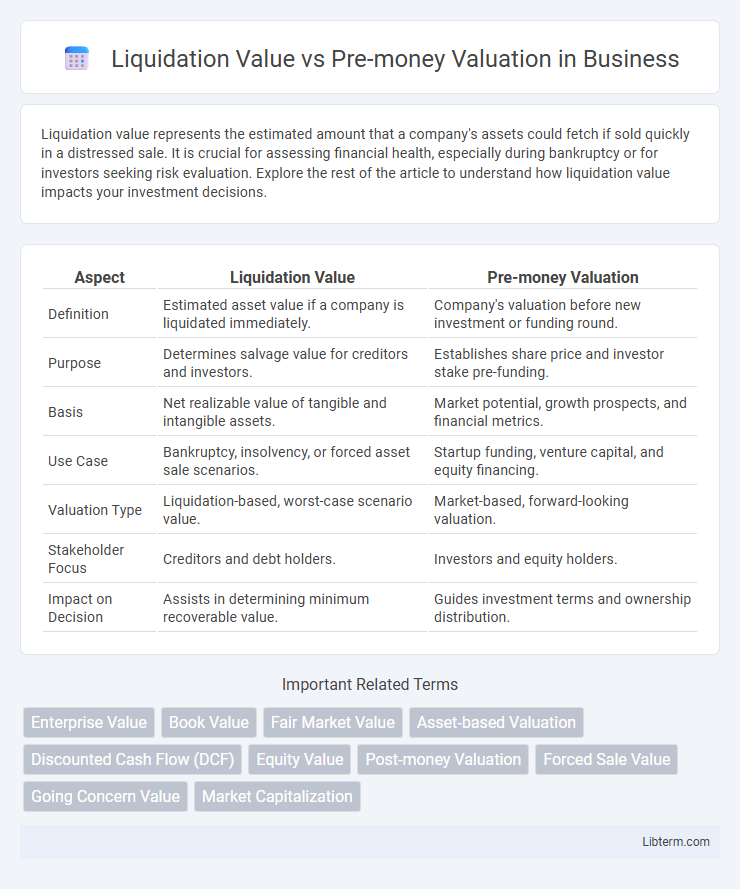Liquidation value represents the estimated amount that a company's assets could fetch if sold quickly in a distressed sale. It is crucial for assessing financial health, especially during bankruptcy or for investors seeking risk evaluation. Explore the rest of the article to understand how liquidation value impacts your investment decisions.
Table of Comparison
| Aspect | Liquidation Value | Pre-money Valuation |
|---|---|---|
| Definition | Estimated asset value if a company is liquidated immediately. | Company's valuation before new investment or funding round. |
| Purpose | Determines salvage value for creditors and investors. | Establishes share price and investor stake pre-funding. |
| Basis | Net realizable value of tangible and intangible assets. | Market potential, growth prospects, and financial metrics. |
| Use Case | Bankruptcy, insolvency, or forced asset sale scenarios. | Startup funding, venture capital, and equity financing. |
| Valuation Type | Liquidation-based, worst-case scenario value. | Market-based, forward-looking valuation. |
| Stakeholder Focus | Creditors and debt holders. | Investors and equity holders. |
| Impact on Decision | Assists in determining minimum recoverable value. | Guides investment terms and ownership distribution. |
Introduction: Understanding Business Valuations
Liquidation value represents the estimated amount a company would fetch if its assets were sold quickly, often under distress, reflecting the minimum worth in a worst-case scenario. Pre-money valuation, on the other hand, denotes the company's value before receiving new external funding, critical for negotiating equity stakes during investment rounds. Understanding these concepts is essential for investors and entrepreneurs to assess financial health, investment risks, and potential returns accurately.
What is Liquidation Value?
Liquidation value represents the estimated amount an asset or company would generate if sold quickly, often under distressed conditions, reflecting its minimum worth in a forced sale. This value is crucial for investors assessing downside risk, as it determines the potential recovery in bankruptcy or dissolution scenarios. Unlike pre-money valuation, which estimates a company's worth before new investment rounds based on growth prospects, liquidation value strictly focuses on tangible asset liquidation under unfavorable circumstances.
Defining Pre-money Valuation
Pre-money valuation refers to the estimated value of a company immediately before it receives new external funding or investment, representing the baseline worth used to calculate equity ownership stakes. It excludes the incoming capital from the funding round, serving as a key metric for both investors and founders during financing negotiations. This valuation impacts shareholder dilution and influences the company's capital structure prior to the infusion of new funds.
Key Differences Between Liquidation Value and Pre-money Valuation
Liquidation value represents the estimated amount a company's assets would fetch if sold off in a forced liquidation, often reflecting a lower, more conservative figure primarily used in bankruptcy or distress scenarios. Pre-money valuation denotes the company's estimated worth before receiving new external funding, crucial for determining equity stakes during investment rounds. The key difference lies in their application: liquidation value assesses downside asset recovery, while pre-money valuation drives investment negotiations and growth projections.
Calculation Methods for Liquidation Value
Liquidation value calculation methods primarily involve estimating the net amount that would be realized if a company's assets were sold off quickly, often at a discount to market value, minus outstanding liabilities. Common approaches include the orderly liquidation method, which assumes assets are sold over a reasonable timeframe, and the forced liquidation method, reflecting a rapid sale under distressed conditions. Pre-money valuation, by contrast, represents the company's estimated worth before new equity investment, based mainly on future earning potential rather than immediate asset liquidation figures.
Approaches to Determining Pre-money Valuation
Pre-money valuation is primarily determined through methods such as comparable company analysis, precedent transactions, and discounted cash flow (DCF) models, each incorporating market conditions, financial performance, and growth projections to estimate a startup's worth before new investments. Unlike liquidation value, which assesses the net cash recoverable if assets are sold off under distress, pre-money valuation captures the company's ongoing operational potential and intangible assets. Venture capitalists rely heavily on these valuation approaches to negotiate equity stakes and forecast potential returns in funding rounds.
Impact on Investors and Founders
Liquidation value represents the estimated return investors receive if a company is sold or liquidated immediately, often lower than pre-money valuation, which reflects the company's worth before new investment rounds. For investors, a higher liquidation preference assures downside protection but can dilute founders' equity and influence control dynamics. Founders face challenges balancing attractive pre-money valuations to secure funding while minimizing investor liquidation rights that could erode their ownership and future gains.
Practical Scenarios: When to Use Each Valuation
Liquidation value is critical in distressed or bankruptcy scenarios, helping stakeholders understand the worst-case recovery from asset sales. Pre-money valuation is essential during investment negotiations, reflecting a startup's worth before new capital infusion to determine equity stakes. Use liquidation value for risk assessment and creditor priorities, while pre-money valuation guides funding rounds and ownership dilution.
Common Misconceptions and Risks
Liquidation value represents the estimated amount a company's assets would fetch if sold quickly during a liquidation event, often significantly lower than market or intrinsic value. Pre-money valuation reflects the company's worth before new investment, based on projected growth and intangible factors, not just tangible asset liquidation. Misconceptions arise when investors confuse liquidation value with pre-money valuation, underestimating the risks of relying solely on liquidation value, which ignores future potential and can lead to undervaluing high-growth startups.
Conclusion: Choosing the Right Valuation Metric
Liquidation value provides a conservative estimate of a company's worth based on the net amount if assets were sold today, while pre-money valuation reflects the company's estimated value before new investment, focusing on future growth potential. Selecting the appropriate valuation metric depends on the context: liquidation value suits risk-averse investors prioritizing downside protection, whereas pre-money valuation aligns with growth-oriented investors and startups seeking funding. Understanding the differences ensures informed decision-making and accurate assessment of investment opportunities.
Liquidation Value Infographic

 libterm.com
libterm.com